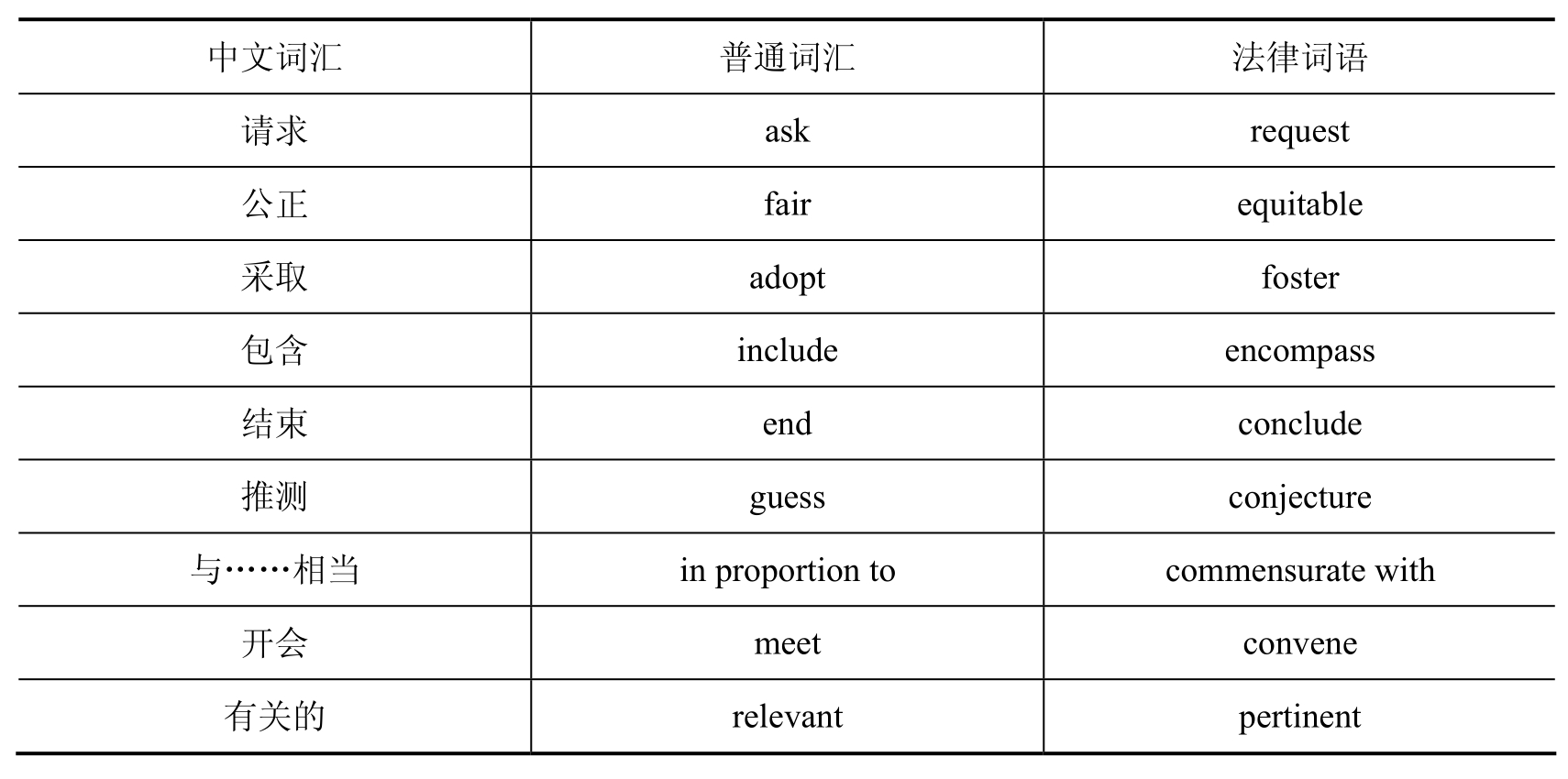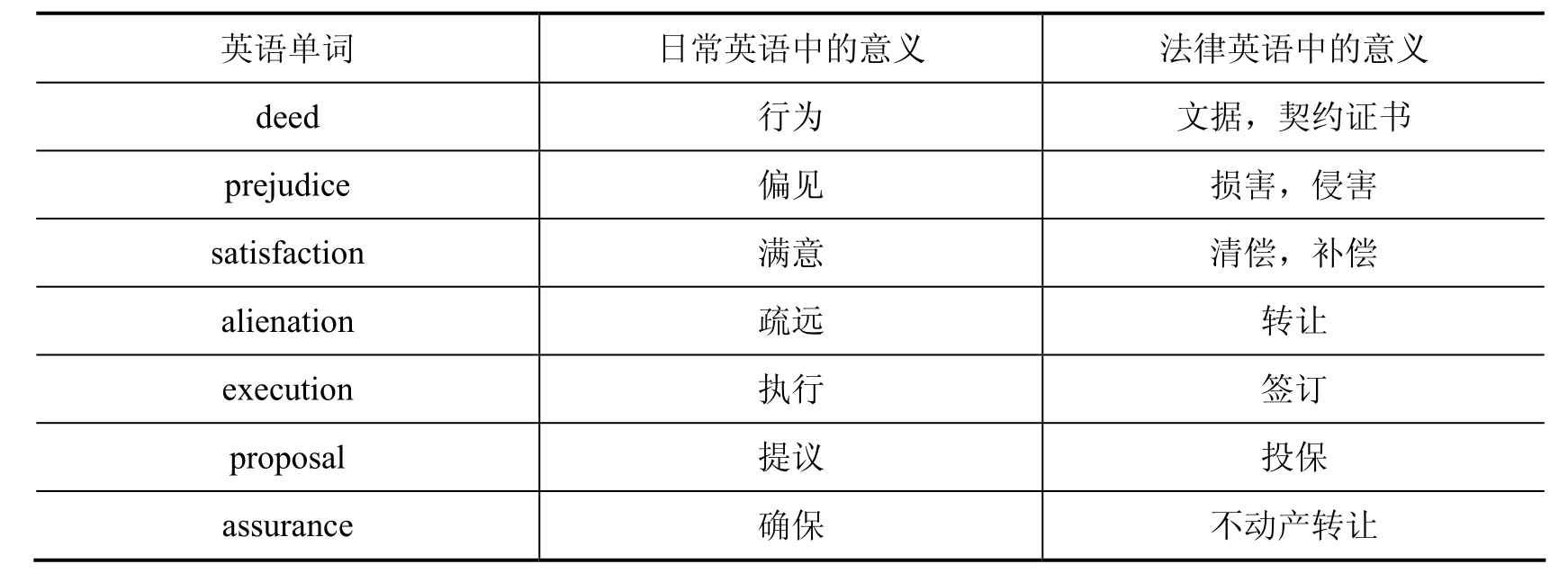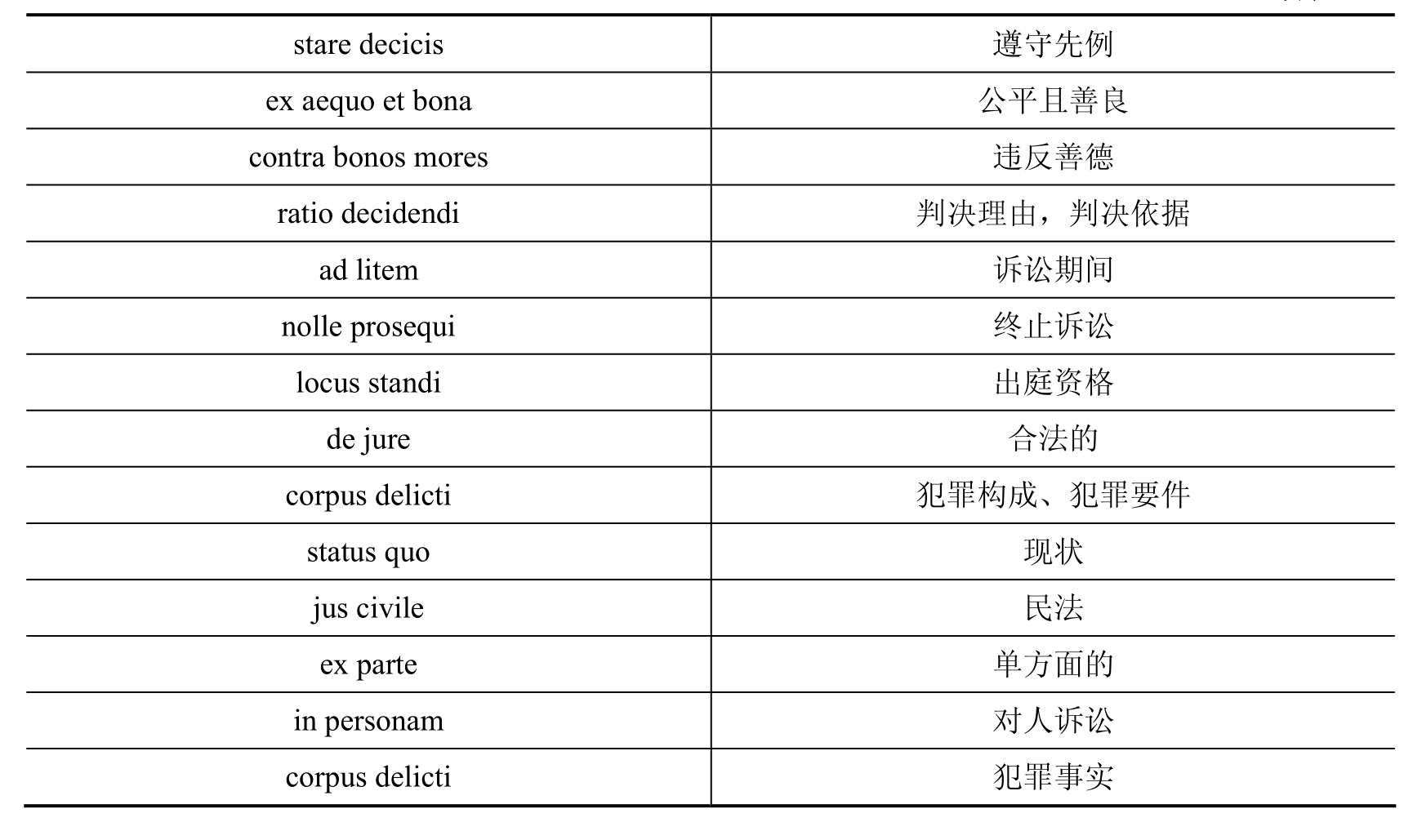第二节 WTO英文文本的语言特色
从1948年的GATT到今天的WTO,WTO已经制定和通过了大量的法律文件和各种协定,以此来规范WTO成员之间的经贸活动。WTO这些法律和协定用三种语言拟定,即英语、法语和西班牙语,三种文本具有同等效力,尤以英文文本的使用最为广泛。WTO英文法律文本具有一定的语言特色,了解这些语言特色有助于我们更好地理解WTO英文文本。
一、词汇特点
WTO英语属于法律英语,而法律英语作为专业英语(ESP)的分支学科之一,具有ESP的一般特点。法律英语是法学与英语语言学间交叉学科研究的结晶,因此其研究应从两个视角进行探析。一方面,按照法律的观点、方法以及法律规范、法律文书的特殊需要来研究英语在法学理论及实践中的运用;另一方面,运用语言学,尤其是应用语言学的基本原理和方法研究法律科学和法律实践的英语语言特点。
1.专业术语、行业套语的使用
WTO法律文件以准确严谨为主要特点,其文体属于庄严文体(The frozen style),其用词、句法结构、文体、行文方式等有其自身的特点和要求。由于WTO协定直接规定成员的权利和义务,其用词自然不同于文学语言的丰富多样性和新闻词汇的时尚创新性,其文本词汇严谨统一,并体现法律文件的庄严冷峻和不带感情色彩的语气。根据对WTO协定分析,我们发现大量使用庄严词语的情况,下面是普通词汇和法律词语的对比分析:
表1

表2

2.频繁使用法语、拉丁语等
法律英语词义的保守性是指词义的不易改变性。法律英语词义的保守性源于人们对权威标准的信仰。古英语时期(公元450—1100年)和中古英语时期(公元1100—1500年)这两个时期法律英语从拉丁语、法语和希腊语中借用的外来法律词汇中有70%仍沿用至今。
(1)法语单词

(2)拉丁语

续表

3.使用成对型近义词
在WTO英语文本中,近义词与同义词并列的现象非常普遍,如:
protocols and certifications 议定书和证明书
foreign-built and foreign-reconstructed vessels 国外建造与国外重造的船只
to improve and strengthen the international trading system 改善和加强国际贸易体系
我们知道,英语法律文本中,经常使用词语的并列结构,这类短语较常见的特点是:
(1)由两个同义词用and连接;或,
(2)由两个或两个以上词性相同、词义相近/相对的词用or连接构成。
例如:terms and conditions(条款),rights and interests(权益),losses and damages(损失),null and void(无效),sign and issue(签发),aid and abet(同谋)、heirs and devisees(继承人和受遗赠人),minor or child or infant(未成年人),acknowledge and confess(承认),fit and proper(适当的),will and testament(遗嘱),stipulation and provision(规定),any part or parts of it (其任何一部分或若干部分),loss or damage(灭失或损坏),express or implied(明示的或暗示的),purchase or sell(购买或销售),in contract or in tort(在合同中或侵权中)等。
成对的同义词和近义词简称“成对词”,语义定义:“A binomial is a sequence of two words pertaining to the same form-class, placed on an identical level of syntactic hierarchy, and ordinarily connected by some kind of lexical link.”
据Mellinkoff等法律语言学家的研究,“成对词”在法律文本中的出现频率是其他一般文体的四至五倍。
下面是一例英文法律文本中“成对词”套语使用的例子:
Under no circumstances shall the company be liable to pay compensation and damages to any person or persons for any loss, injury, or damage whatsoever occasioned by this product or as a result of the use, misuse, or abuse of this product, whether arising in contract or in tort, and all warranty express or implied ( save as above ) is specifically excluded.
在该英文法律文本中,就连续使用了6个and 或or 连接词或短语,它们分别是:
compensation and damages 赔偿或赔偿金(连接近义词,表示互补关系):
person or persons 一人或多人(连接同义词,表示选择关系):
injury, or damage 损伤或损坏(连接近义词,表示递进关系):
misuse, or abuse 误用或滥用(连接近义词,表示递进关系):
in contract or in tort 在合同中或在侵权行为中(连接相对词,表示补充关系):
express or implied 明示的或暗示的(连接反义词,表示对照关系):
The General Agreement on Tariffs and Trade 1994 (“GATT 1994”) shall consist of: (a) the provisions in the General Agreement on Tariffs and Trade, dated 30 October 1947, annexed to the Final Act Adopted at the Conclusion of the Second Session of the Preparatory Committee of the United Nations Conference on Trade and Employment (excluding the Protocol of Provisional Application), as rectified, amended or modified by the terms of legal instruments which have entered into force before the date of entry into force of the WTO Agreement;…
1994年关税与贸易总协定(1994年的GATT)共有:(a)作为联合国贸易与就业大会预备委员会第二次会议结束时通过的最终文件的附件、日期为1947年10月30日的《关税与贸易总协定》的规定(不包括临时适用议定书),已按照WTO协议生效日前已生效的法律文件中的措词加以更正、修正或修改;……
4.古英语词语的使用
在WTO的所有协定中,几乎都能找到这样的行文“Members,...Hereby agree as follows:(各成员,……特此协议如下:)此处的“hereby”为古英语词汇,这类词语一般都用于法律文件中,体现其典型的国际协议的行文体例和风格。这类词语大多以“here”,“there”开头,部分以“where”开头。以here和there开头的这类词语几乎可以互用。
除此之外,在法律文献中出现频率较高的古体词汇还有:aforementioned(上述的),aforesaid(如前所述),thence(从那时起),thenceforth(其后,从那时起),whosoever(不管是谁)等等。
大量古体词汇的频繁使用,使得WTO文本古朴精练,庄重严肃。
古词的频繁使用是法律英语词汇最显著的特点之一。一些古词在现代英语中,尤其是在现代英语口语中已不再使用,但在法律文书或正式的司法场合仍在使用。古词ye 是you的复数“你们”,在普通英语中早已不再使用。但在法庭开庭时仍沿用hear ye“静听”(宣读、审判),或用古词oyez“静听”。这里的hear ye实际上相当于现代英语中的listen up!古词sayeth相当于现代英语中的say,这在普通英语中早已不用了,但在法庭上仍然使用。
Members shall comply with Articles 1 through 21 of the Berne Convention (1971) and the Appendix thereto. However, Members shall not have rights or obligations under this Agreement in respect of the rights conferred under Article 6 is of that Convention or of the rights derived therefrom.
此句中的thereto和therefrom都是复合副词。thereto可理解为to there或to that,there from可理解为from there或from that。
译:各成员均应遵守《伯尔尼公约》(1971)第一条至第二十一条及其附录。但就《伯尔尼公约》第六条附则下授予的权利或该附则中引出的权利而言,各成员不应享有或承担本协议的权利或义务。
This Agreement applies to the products listed in Annex 1 to this Agreement, hereinafter referred to as agricultural products.
本协议适用于本协议附件1中所列以下被称作农产品的产品。
The domestic support and export subsidy commitments in Part IV of each Member’ s Schedule constitute commitments limiting subsidization and are hereby made an integral part of GATT 1994.
在成员减让表第四部分中的国内支持和出口补贴承诺构成限制补贴的承诺,在此作为1994年关贸总协定不可分割的组成部分。
5.动词名词化
动词名词化是指动词的词性作用转化为名词的表现形式,常与修饰语或附加成分一起构成一个短语。动词名词化组合方式众多,意义容量大,表达简洁客观。这种现象在WTO文本中表现非常突出。为了使国际法规具有严肃性,同时又避免出现真正意义上的执行者,动词名词化就让原来的施动意义隐含在结构深层里面,其表述语气也从“动”到“静”,更符合文本目的,也更容易为目的语读者所理解并遵守。例如:
Members may avail themselves of the exceptions permitted under paragraph 1 in relation to judicial and administrative procedures, including the designation of an address for service or the appointment of an agent within the jurisdiction of a Member, only where such exceptions are necessary to secure compliance with laws and regulations which are not inconsistent with the provisions of this Agreement and where such practices are not applied in a manner which would constitute a disguised restriction on trade.
在司法和行政程序方面,各成员均可利用本条第一款允许之例外,包括在各成员管辖权范围内指定服务地址或任命代理人,但此一例外应为确保遵守与本协议规定不相符合的法律和法规所必需,且此类行为的实施未构成对贸易的变相限制。
英汉两种语言在表现形式上有所不同,英语是以名词占优势的语言,而汉语则是以动词占优势。陈明瑶(2004)等主张,英译汉时拟考虑把已经名词化了的动词再翻译为汉语动词,使原来的名词短语成为主谓结构或动宾结构,这样就更方便目的语阅读者的接受。又如:
The obligations under Articles 3 and 4 do not apply to procedures provided in multilateral agreements concluded under file auspices of WIPO relating to the acquisition or maintenance of intellectual property rights.
第三条和第四条项下的义务不适用于由WIPO主持缔结的多边协议中有关获得和维持知识产权的程序。
二、句法特征
1.被动语态的使用
WTO英文文本中大量使用被动句,是由法律文本的客观性所决定的。作为法律英语的一般规则,句子中的行为主体不但要明示,而且应置于句首。但被动结构有利于表达法律语言的概括性特征,最大特点就是不带个人的主观性。法律文本的功能是传达信息,核心就是客观真实可信,因而法律英语常用被动句。
例1:The domicile of a citizen shall be the place where his residence is registered;if his habitual residence is not the same as his domicile,his habitual residence shall be regarded as his domicile.
公民以他的户籍所在地的居住地为住所,经常居住地与住所不一致,经常居住地视为住所。
例2:The formation of this Contract, its validity, interpretation, execution and settlement of disputes in connection herewith shall be governed by the laws of the People’s Republic of China (“PRC”), but in the event that there is no published and publicly available law in the PRC governing a particular matter relating to this Contract, reference shall be made to general international commercial practices.
本合同的订立、效力、解释、执行及合同争议的解决,均受中华人民共和国法律管辖。中国颁布的法律对本合同相关的某一事项未作规定的,参照国际商业惯例。
例3:Unless otherwise specified in writing herein, all Confidential Information must be returned to the disclosing Party or destroyed on the expiration of the period of the receiving Party’s using such Confidential Information.
除非本协议另有书面规定,所有机密信息在接收方使用期限届满时必须退还给披露方或者销毁。
例4:Where the disputes arising out of or in relation to this Contract can not be resolved within fifteen (15) days after any Party hereto requesting in writing the other Party to commencing a consultation on said disputes, either Party may submit it to the China International Economic and Trade Arbitration Commission for arbitration(CIETAC).
如果在合同任何一方向对方发出就因本合同引起的或与之有关的任何争议进行协商的书面请求后15天内,争议仍未得到解决,则任何一方可以将该争议提交中国国际经济贸易仲裁委员会仲裁。
2.句子冗长、结构复杂
WTO英文法律文本的另一个明显的语言特色便是句子冗长、结构复杂。这主要由于起草WTO契约条款的人首先着眼于文字的严谨和准确、庄重和规范,因而他们总是采取一切可能的手段防止误解或歧义现象的发生。为了稳妥和避免可能引起的误解,WTO规则起草人和律师都常常援引成规范例。这样便不可避免地导致句子冗长复杂。
有研究表明(夏康明等,2007):WTO英文文本句式结构与其他一般文体有所不同,其句子长度远远超过一般英语句子的长度平均17.8个词左右。大多数WTO条款句子的长度可达到一般英语句子平均长度的好几倍,有时一两个句子便构成一个段落,句子结构也非常复杂,往往包含较多的从句如定语和状语从句、修饰短语如介词、形容词和抽象名词短语等。因而WTO英文文本句子大多冗长复杂,难以理解。
例:All quantitative restrictions within bilateral agreements maintained under Article 4 or notified under Article 7 or 8 of the MFA in force on the day before the entry into force of the WTO Agreement shall, within 60 days following such entry into force, be notified in detail, including the restraint levels, growth rates and flexibility provisions, by the Members maintaining such restrictions to the Textiles Monitoring Body provided for in Article 8 (referred to in this Agreement as the “TMB”). (word count=80)
在WTO协定生效前一日已生效的、根据MFA第4条维持的或根据第7条或第8条做出通知的双边协定范围内的所有数量限制,应在WTO协定生效起60天内由维持此类限制的成员向本协定第8条规定的纺织品监督机构(本协定中称“TMB”)做出详细通知,包括限制水平、增长率和灵活条款。
该条款的长度是一般英语句子长度的4.5倍多。造成该条款冗长复杂的主要因素有以下几个因素:
(1)众多的过去分词做后置定语,例如:bilateral agreements maintained under Article 4 or notified under Article 7 or 8 of the MFA. 根据MFA第4条维持的或根据第7条或第8条做出通知的双边协定。
the Textiles Monitoring Body provided for in Article 8. 第8条规定的纺织品监督机构。
referred to in this Agreement as the “TMB”. 本协定中称“TMB”。
(2)大量介词短语做定语,例如:
All quantitative restrictions within bilateral agreements. 双边协定范围内的所有数量限制。
under Article 4 or under Article 7 or 8 of the MFA.
根据MFA第4条或根据第7条或第8条。
within 60 days following such entry into force. 在WTO协定生效起60天内。
including the restraint levels, growth rates and flexibility provisions. 包括限制水平、增长率和灵活条款。
(3)主语与谓语、谓语与谓语被介词短语分隔,如主语 All quantitative restrictions与情态动词shall被within bilateral agreements等多个介词短语分隔;谓语shall be notified也被一介词短语within 60 days following such entry into force 所分隔开来。
3.状语分句的使用
WTO法律文书中关于义务部分的陈述是至关重要的,它是享受权利的前提和条件。在WTO英语中关于义务的陈述表现在句子结构上,往往使用条件状语分句或让步状语分句。
例1:If two or more applicants apply for registration of identical or similar trademarks for the same kind of goods or similar goods, the trademark whose registration was first applied for shall be given preliminary examination and approval and shall be publicly announced; if the applicants are filed on the same day, the trademark which was first used shall be given preliminary examination and approval and shall be publicly announced, and the applications of the others shall be rejected and shall not be publicly announced.
两个或者两个以上的申请人,在同一种商品或者类似商品上,以相同或者近似的商标申请注册的,初步审定并公告申请在先的商标;同一天申请的,初步审定并公告使用在先的商标,驳回其他人的申请,不予公告。
在法律英语中除了if…引导的条件状语分句外,还常常使用由whereas…,provided that…,where…,when…等引导的状语分句。
例2:When a party assigns,wholly or in part,its contractual rights and obligations to a third party,it must obtain the consent of the other party.
当事人一方将合同权利和义务的全部或者部分转让给第三人的,应当取得另一方的同意。
例3:Where using other’s registered trademarks has been permitted,the names of the licensee and the production place of the commodity must be marked in the commodity using the registered trademark.
经许可使用注册商标的,必须在使用该注册商标的商品上标明被许可人的名称和商品产地。
4.定语从句的使用
WTO法律英语较之普通英语更准确,限定更严谨,所以限定性定语从句运用得比较普遍,而作为补充、说明、解释性的非限制性定语从句用得比较少。我们现在来观察以下例句。
例1:The licensee shall give the Licensor in writing full particulars of any use or proposed use by any other person, company of a trade name, trademark, or get-up of goods, means of promotion or advertising which amounts to or is likely to amount to infringement of the rights of the Licensor in relation to the Licensed Trademarks or contravention of the Anti-unfair Competition Law as soon as it becomes aware of such use or proposed use.
一旦获悉任何其他个人、公司使用或拟使用的商品名称、商标、商品装饰、促销或广告手段,构成或可能构成对许可方有关受许可商标权利的侵犯或违反反不正当竞争法,受许可方应以书面形式将详细情况通知许可方。(限制性定语从句)
例2:Questions concerning matters governed by this convention which are not expressly settled in it are to be settled in conformity with the general principles on which it is based or, in the absence of such principles, in conformity with the law applicable by virtue of the rules of private international law.
凡本公约未明确解决的属于本公约范围的问题,应按照本公约所依据的一般原则来解决,在没有一般原则的情况下,则应按照国际私法规定适用的法律来解决。(限制性定语从句)
免责声明:以上内容源自网络,版权归原作者所有,如有侵犯您的原创版权请告知,我们将尽快删除相关内容。















